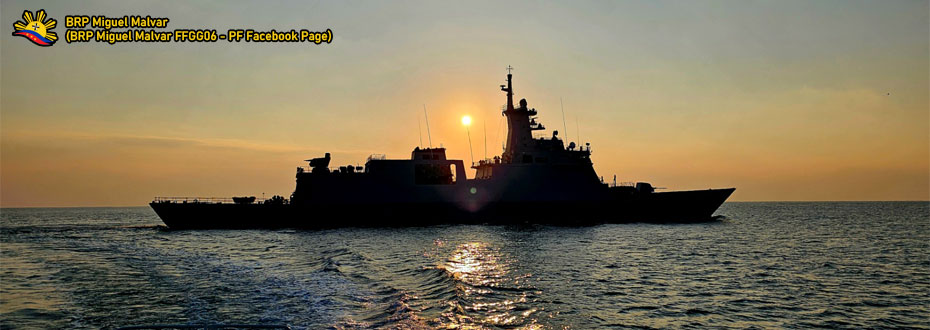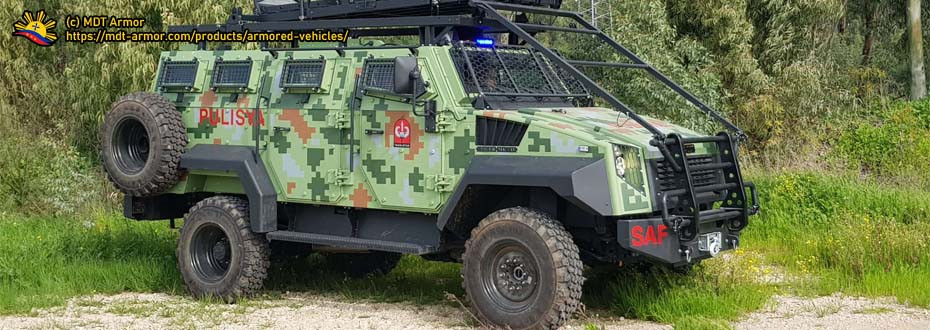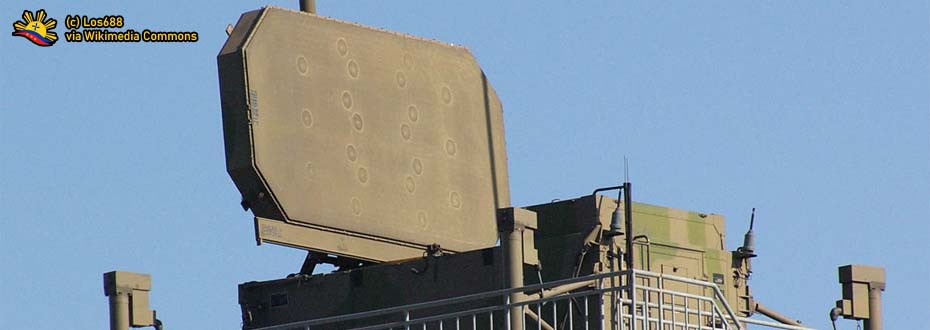Additional white hull ships are already in the Philippine Coast Guard's bucket list for quite some time now, with additional plans for acquisition already on its way with countries like Japan providing more for the next five years.
As the maritime law enforcement agency's role becoming more essential than ever, so do the prospects of several shipbuilding companies to what might be a marketing pitch for a platform that the Philippine Coast Guard might consider for its maritime fleet expansion efforts.
A SCALE MODEL IN AN EXPOSITION
 |
HD Hyundai Heavy Industries unveil a scale model of the HDP-2200 Offshore Patrol Vessel, painted in Philippine Coast Guard color.
Image Source. |
It is a usual and well-known practice among shipbuilding to showcase various types of warship designs through the scale models presented in defense-related or similarly crafted expositions and exhibitions, whereby the warship designs are a prospect of an offer of the shipbuilder to a certain country for its own mission requirements. Also, it serves some designs that are already a work in progress, with navies already set orders for the acquisition of actual units for their fleet operations.
With the designs that a shipbuilder also comes with an interesting tidbit on the offers made, likely aiming to market the product for operational use that involves maritime patrol objectives or to enhance the country’s
maritime domain awareness even further.
This is precisely the case for HD Hyundai Heavy Industries in a recently concluded exposition in South Korea, primarily catering to the Korean Coast Guard and other maritime-related bodies in the country.
In the event, HD Hyundai Heavy Industries, like other Korean-based and foreign companies that took part in the exhibition,
provide their respective scale model designs and other stuff that might look fascinating for the Korean law enforcement agencies to consider for their respective requirements. In that case, the shipbuilding company presented their usual product design, with an interesting tidbit regarding the coast guard stripes that the scale model presented.
As seen in the image provided above, the HDP-2200 offshore patrol vessel design of the HD Hyundai Heavy Industries is sporting a Philippine Coast Guard stripes and livery, even coming with a referenced scale model of what seems to be the AW-159 anti-submarine helicopter with the maritime law agency’s colors. Apparently, the presentation of the vessel might provide an idea that the Korean shipbuilder is interested in taking part in the Philippine Coast Guard’s ongoing modernization efforts.
As for the latter, the Offshore Patrol Vessels that the Philippine Navy sets to receive come similarly to the scale model design with Philippine Coast Guard colors, minus a helo hangar.
In this topic, the discussion delves deep into the ongoing modernization efforts of the Philippine Coast Guard in terms of its white hull vessel requirements, along with the specifications of the HDP-2200 patrol vessel design and its difference to the ones provided for the Philippine Navy requirements. Finally, the correlation between the Philippine Coast Guard’s modernization and its role in the West Philippine Sea will also get covered accordingly.
SCALE MODEL FIRST SIGHTED IN KOREA OCEAN EXPO 2024
 |
| The Korea Ocean Expo also exhibits advanced technologies, such as the Unmanned Surface Vehicle (USV) seen in the image. Retrieved from an Image Source. |
Showcasing the product designs and future visions have always got a presentation through an exhibition or exposition typically conducted at a certain convention center in a notable city within a country, with the end users and relevant stakeholders usually conducting and sponsoring the activity. This aims to showcase any products offered by a company of specific expertise, like those with shipbuilding, that might help improve the end users and stakeholder capabilities.
For the Korea Ocean Expo, it markets itself as the
only marine-specialized exhibition within the country, aiming to provide an attraction of interest among major maritime organizations, as well as maritime organization within the confines of South Korea’s key metropolitan areas like in Seoul or the adjacent city of Incheon. From this exhibition, it only makes sense for shipbuilding companies like HD Hyundai Heavy Industries to showcase its products at the exhibition.
This exposition comes the opportunity for local South Korean firms like HD Hyundai Heavy Industries to showcase its products, suites, and mission-based solutions that might find applicable or appropriate to the end-user requirements for clients like the Korea Coast Guard. It is also from this venue that product solutions present the current push of each firm on their current developments or projects pushed, which have led to the aforementioned shipbuilder to showcase a scale model with Philippine Coast Guard colors.
With different marine firms and shipbuilding companies pushing their respective marketing pitch, hoping that key South Korean maritime-oriented government agencies such as the South Korean Coast Guard will take their offer, the different offers and scale model designs that speak perspectives of each firms provide any sign or an indicator that expresses their interest, especially that HD Hyundai Heavy Industries actively producing the similarly designed offshore patrol vessel platform for the Philippine Navy.
THE HDP-2200 VESSEL
The scale model provided in a Korean exposition came as the HDP-2200 offshore patrol vessel, whereby it shares design cues with the HDP-2200+ offshore patrol vessel that the Philippine Navy will eventually have, except for some minor tweaks in the design as those type of information will delve deeper throughout this sub-discussion.
Despite the tweaks, both share similar dimensions on the ship's size and tonnage, although the differences show the effective modularity of the offshore patrol vessel design.
As provided in the product brochure by HD Hyundai Heavy Industries for the said offshore patrol vessel design, both the HDP-2200 and the HDP-2200+ design share the most attribute on its capability and other key specifications, whereby both have the displacement of 2,450 tons, overall length of 94.4 meters, breadth of 14.3 meters, draught of 3.7 meters, speed of 22 knots, range of 5,500 nautical miles, and maximum endurance at sea at 30 days.
Both platforms have space for two (2) Rigid-Hull Inflatable Boats or RHIBs, a single helipad for a helicopter to land and take off, and also having similar design features on how the bridge and the navigational mast get positioned.
The clear difference between both the HDP-2200 and the HDP-2200+ offshore patrol vessel design, as provided in the brochure, is in terms of weapons subcomponents involved and essential features that define one vessel's design objectives to the other.
One clear difference is in the helicopter hangar, whereby the HDP-2200 Offshore Patrol Vessel always come with a single hangar for a dedicated helicopter platform to shelter in, whereas this feature comes absent to the HDP-2200+ Offshore Patrol Vessel that the Philippine Navy purchased under the Offshore Patrol Vessel or OPV Acquisition Project. With one lacking feature always comes with a tradeoff, as the HDP-2200+ design always comes with more firepower as compared to the HDP-2200 variant.
For example, as provided again in the brochure of the HD Hyundai Heavy Industries for both platforms, the weapons and sensors suite of the HDP-2200+ offshore patrol vessel comprise with additional weaponry features as compared to ones found onboard the HDP-2200 offshore patrol vessel variant.
Weapons such as Close-In Weapons System or CIWS, 76mm main gun, Combat Management System or CMS, and even Unmanned Aerial Vehicles or UAVs, are coming with the HDP-2200+ OPV and are absent on the HDP-2200 OPV.
The highlighted difference makes the HDP-2200 Offshore Patrol Vessel more ideal as a platform intended for the Philippine Coast Guard or the PCG, whereby the maritime law enforcement agency does not require naval subcomponents for its operations and instead use lighter armaments and even water cannons to enforce its mandate in the high seas. The availability of the helicopter hangar enables its helicopters, like the Airbus H145, to shelter on and use for Maritime Search and Rescue operations.
This offer gets timely, as the Philippine Coast Guard now has an actual requirement to beef up its capabilities, particularly regarding the increase in the number of its existing white hull vessels that addresses all the shortcomings of the maritime law enforcement agency, especially for the support of Filipino fisherfolk and increased presence of Philippine authorities in the West Philippine Sea. Added to this is the increased aggression by the China Coast Guard that inflicted damage on the PCG vessels.
PCG'S PLAN FOR FLEET IMPROVEMENT
 |
| The ongoing tensions in the West Philippine Sea give more justification to the increase of Philippine Coast Guard vessel acquisition plans. |
Recent developments, such as the one in the West Philippine Sea, as depicted in the image above involving the deployment of BRP Teresa Magbanua (MRRV-9701) and BRP Cabra (MRRV-4409) of the Philippine Coast Guard in Escoda (Sabina Shoal), gives additional justification for the need of additional white-hulled vessels for the Philippine Coast Guard to get. Case in point, China did the ramming to the MRRV-9701 that it eventually needs to get pulled out from the area back to the mainland for repairs.
As expected, the Philippine Coast Guard will probably tap both Japan and France for its white-hulled vessel requirements, as it is with these countries that help provide the bulk of the actively serving white hulls that the maritime service branch currently uses, such as the ten (10) Parola-class Multirole Response Vessels that Japan provided on top of the aforementioned ninety-seven (97) meter long vessels, and the smaller, 24-meter Boracay-class patrol boats from France, along with BRP Gabriela Silang (OPV-8301).
While there is a preference with Japanese-built vessels like the Teresa Magbanua-class Multirole Response Vessels and also to the French-made ones, the HDP-2200 offer provided by the HD Hyundai Heavy Industries actually has benefits, particularly in terms of interoperability and logistics chain with the Philippine Navy’s HDP-2200+ Offshore Patrol Vessels purchased. This is particularly the case when the Philippine Coast Guard seeks an interest in securing vessels made by the Australian shipbuilder Austal.
The necessity of getting additional white hull vessels in the height of increasing tension in the West Philippine Sea by overseas intruders gives added justification that shipbuilders like HD Hyundai Heavy Industries can attempt to market for the Philippine Coast Guard to consider, especially that this move will also enable the South Korean shipbuilder to get a portion of the organization’s shipbuilding pie, expanding its market in the Philippines aside from its usual prospect with the Philippine Navy.
MORE TO COME
 |
Other vessel designs as presented by HD Hyundai Heavy Industries during the Asian Defense And Security Exhibition or ADAS 2024.
Image from Department of National Defense. |
Aside from the HDP-2200 Offshore Patrol Vessel, HD Hyundai Heavy Industries actually provided a wide range of options that the Philippine Coast Guard might consider during the three-day Asian Defense and Security Exhibition or ADAS 2024 that took place from September 25-27, 2024. Since the offers go beyond the single type of vessel that came with this topic, this discussion deserves its own separate entry that is entirely accessible on this website resource medium.
Showcasing the HDP-2200 Offshore Patrol Vessel scale model with Philippine Coast Guard colors once again, coupled with a multiple range of different scale models for offshore patrol vessel sizes still with the said colors, come as a sign that HD Hyundai Heavy Industries is serious in marketing and providing its solutions for the maritime law enforcement agency to consider, an indicator of its planned expansion in the Philippine maritime market.
With the role of the Philippine Coast Guard into ensuring the country’s presence in the West Philippine Sea, and also in expanding its current capability for Maritime Domain Awareness, they may have a chance in considering the offshore patrol vessels made by HD Hyundai Heavy Industries for its operations, as this boost the number of vessels that help complement the
97-meter Teresa Magbanua-class Multirole Response Vessels in patrolling and deterring Chinese activity in the West Philippine Sea.
This also goes similarly with the offer made by the Australian shipbuilder Austal, as it presented the
Improved Cape-class Multirole Response Vessel as part of its offer to the Philippine Coast Guard. The presented offer goes primarily in line with the sixty-one (61) meter offshore patrol vessel requirement the maritime law enforcement agency seeks on as part of the forty-six (46) white hulls needed. This recent offer by Austal also deserves its own separate entry within this website resource medium.
Presentations provided by the shipbuilders also give an indication of the Philippine Coast Guard’s serious interest in improving the number of white-hulls in the fleet, expanding its capability of increasing its presence within the country’s territorial and Exclusive Economic Zone waters, while flying the flag and ensuring the country’s lawful operations in areas like the West Philippine Sea as they operate in coordination with the Bureau of Fisheries and Aquatic Resources or BFAR and the Philippine Navy.
The growth of the Philippine Coast Guard fleet also comes as part of its own modernization push, in which this goes differently to the ones typically discussed as part of the Revised Armed Forces of the Philippines Modernization Program or RAFPMP, that typically comes with its own special item in the annually enacted General Appropriations Act. Both of which underscore the Philippine government’s need for improving its territorial defense posture, ensuring national sovereignty and territorial integrity.
Looking forward, the Philippine Coast Guard’s desire to expand its fleet composition may help improve the capabilities of the Philippine government to use its resources that ensures national security and interest of the citizenry gets protected, especially with providing added support to the Filipino fisherfolk who make a livelihood in the high seas. Also, this ensures protection of the country’s waters against unwanted smugglers and intruders that puts more harm than good on the nation’s own well-being.
























